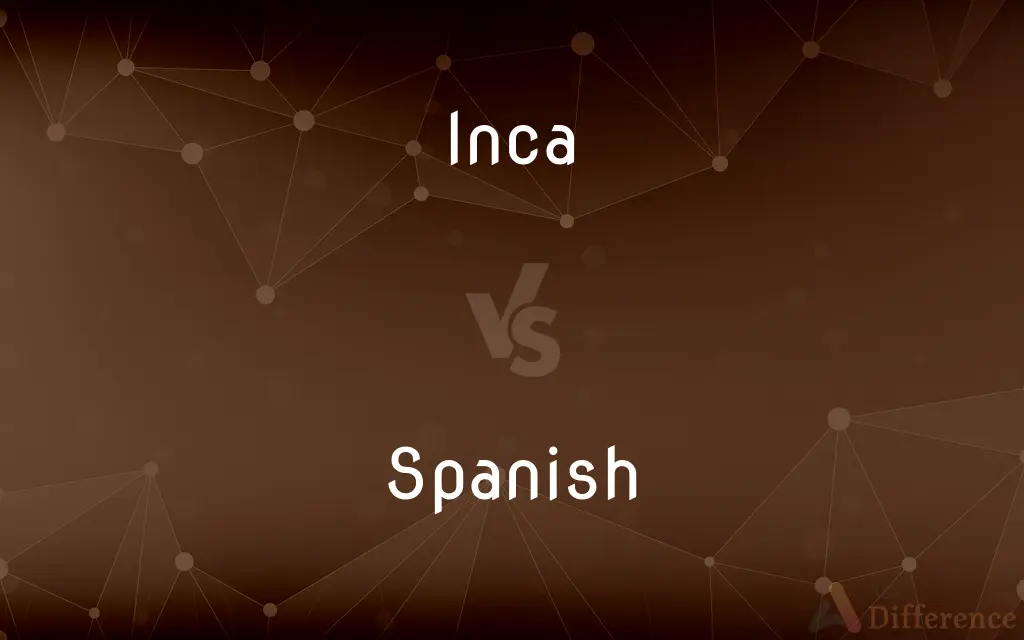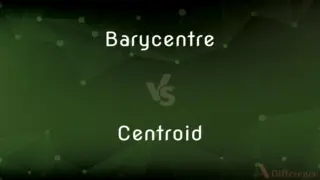Inca vs. Spanish — What's the Difference?
By Fiza Rafique & Urooj Arif — Updated on April 6, 2024
The Inca Empire was a sophisticated pre-Columbian civilization in South America, while the Spanish were a European power that conquered the Incas in the 16th century.

Difference Between Inca and Spanish
Table of Contents
ADVERTISEMENT
Key Differences
The Inca Empire, flourishing in the Andean region of South America, was renowned for its advanced agricultural techniques, intricate road systems, and unique architecture. This civilization had a complex social structure and governance centered around the Sapa Inca, considered a divine ruler. On the other hand, the Spanish were a European power from the Iberian Peninsula, known for their exploration, conquests, and the establishment of a vast colonial empire across the Americas, Africa, and Asia.
While the Incas developed innovative methods to adapt to their environment, such as terrace farming and sophisticated irrigation systems, the Spanish introduced European technologies, animals, and crops to the New World, significantly impacting the native ecosystems and societies. The Inca's achievements in engineering and architecture, including the construction of Machu Picchu and the network of roads and bridges, contrast with the Spanish's construction of colonial cities and fortresses using European architectural styles.
The Spanish conquest of the Inca Empire in the 16th century, led by Francisco Pizarro, marked a pivotal moment in history. The conquest was facilitated by superior military technology, such as firearms and steel armor, and was exacerbated by internal conflicts within the Inca Empire and diseases brought by the Europeans. This encounter between the Incas and the Spanish led to the collapse of the Inca civilization and the establishment of Spanish colonial rule in South America.
The cultural legacy of the Incas is preserved in modern South American societies through language, cuisine, and traditions, reflecting the enduring influence of Inca civilization. Conversely, the Spanish left a lasting impact on the continent through the spread of the Spanish language, Christianity, and European cultural practices. The blend of Indigenous and Spanish influences is evident in the diverse cultures of South America today.
The encounter between the Incas and the Spanish is a study in contrasts: one of a rich, indigenous civilization with deep connections to its land and traditions, and the other of a powerful, expansionist empire with advanced technology and a different worldview. This historical interaction reshaped the social, cultural, and political landscapes of South America, leading to a complex fusion of Indigenous and European elements that characterizes the region to this day.
ADVERTISEMENT
Comparison Chart
Time Period
Approximately 1400–1533 AD
16th Century onwards
Region
Andean South America
Iberian Peninsula, global colonies
Key Achievements
Advanced agriculture, road systems, architecture
Exploration, conquest, colonial administration
Social Structure
Hierarchical, centered on the divine Sapa Inca
Feudal and hierarchical, centered on monarchy
Conquest
Expansion through negotiation, warfare
Global conquests, including the Americas
Technology
Stone architecture, irrigation systems
Firearms, steel armor, maritime navigation
Cultural Legacy
Quechua language, terraced farming
Spanish language, Christianity, European law
Impact of Encounter
Collapse of Inca civilization, cultural integration
Expansion of Spanish colonial empire, cultural exchange
Compare with Definitions
Inca
Unique social and economic systems.
The Incas used a labor tax system called mita for public works.
Spanish
European power known for global exploration.
The Spanish established a vast colonial empire in the Americas.
Inca
Advanced in agriculture and architecture.
Incas developed terrace farming and built Machu Picchu.
Spanish
Led the conquest of the Inca Empire.
Francisco Pizarro defeated the Incas in 1532.
Inca
Governed by a divine ruler.
The Sapa Inca was considered the son of the sun god, Inti.
Spanish
Influenced global culture and language.
Spanish is one of the most spoken languages worldwide.
Inca
Pre-Columbian civilization in South America.
The Inca Empire was known for its impressive road systems.
Spanish
Left a lasting legacy in the Americas.
The colonial cities and Christianity are significant Spanish influences.
Inca
Culture influenced modern South America.
Quechua, the language of the Incas, is still spoken today.
Spanish
Introduced European technologies and animals.
The Spanish brought horses and firearms to the New World.
Inca
A member of the group of Quechuan peoples of highland Peru who established an empire from northern Ecuador to central Chile before the Spanish conquest.
Spanish
Relating to Spain, its people, or its language.
Inca
A ruler or high-ranking member of the Inca Empire.
Spanish
The people of Spain.
Inca
A member of any of the peoples ruled by the Incas.
Spanish
A Romance language spoken in Spain and in much of Central and South America (except Brazil) and several other countries. It is the second most widely spoken first language in the world, with more than 400 millon speakers.
Inca
Any of several species of hummingbirds in the genus Coeligena
Spanish
Of or relating to Spain or its people or culture.
Inca
An emperor or monarch of Peru before, or at the time of, the Spanish conquest; any member of this royal dynasty, reputed to have been descendants of the sun.
Spanish
Of or relating to the Spanish language.
Inca
A ruler of the Incas (or a member of his family)
Spanish
The Romance language of the largest part of Spain and most of Central and South America.
Inca
A member of the small group of Quechuan people living in the Cuzco valley in Peru who established hegemony over their neighbors to create the great Inca empire that lasted from about 1100 until the Spanish conquest in the early 1530s
Spanish
(used with a pl. verb) The people of Spain.
Spanish
(printing) To subject to spanishing, a printing process in which an ink is deposited on the bottoms and sides of depressions formed in a plastic material
Spanish
Of or pertaining to Spain or the Spaniards.
Spanish
The language of Spain.
Spanish
The Romance language spoken in most of Spain and the countries colonized by Spain
Spanish
The people of Spain
Spanish
Of or relating to or characteristic of Spain or the people of Spain;
Spanish music
Common Curiosities
How did the Incas adapt to their environment?
The Incas adapted through terrace farming, irrigation systems, and constructing buildings with earthquake-resistant techniques.
What advantages did the Spanish have over the Incas?
The Spanish had superior military technology, including firearms and steel armor, and exploited internal divisions within the Inca Empire.
What happened to the Inca Empire?
The Inca Empire was conquered by the Spanish, leading to the collapse of Inca civilization and the establishment of Spanish colonial rule.
What was the significance of Machu Picchu?
Machu Picchu is a symbol of Inca engineering skill and their ability to integrate architecture with the natural landscape.
Who were the Spanish in the context of the Inca Empire?
The Spanish were European explorers and conquerors who defeated the Inca Empire in the 16th century, leading to Spanish colonial rule in South America.
How has Spanish influence persisted in modern South America?
Spanish influence remains through the widespread use of the Spanish language, Christian religion, and legal systems.
How do the Inca and Spanish civilizations differ in their legacies?
The Inca legacy is seen in agriculture, language, and traditions in South America, while the Spanish legacy includes language, religion, and colonial architecture.
What is the importance of studying the encounter between the Incas and Spanish?
Studying this encounter helps understand the complex cultural exchanges, the impact of colonization, and the development of modern South American societies.
What was the Inca Empire?
The Inca Empire was a sophisticated civilization in South America, known for its advanced agriculture, road systems, and architecture.
What role did disease play in the conquest of the Incas?
Diseases brought by Europeans, such as smallpox, devastated Indigenous populations, including the Incas, weakening their societies.
Share Your Discovery

Previous Comparison
Barycentre vs. Centroid
Next Comparison
Bell vs. TongueAuthor Spotlight
Written by
Fiza RafiqueFiza Rafique is a skilled content writer at AskDifference.com, where she meticulously refines and enhances written pieces. Drawing from her vast editorial expertise, Fiza ensures clarity, accuracy, and precision in every article. Passionate about language, she continually seeks to elevate the quality of content for readers worldwide.
Co-written by
Urooj ArifUrooj is a skilled content writer at Ask Difference, known for her exceptional ability to simplify complex topics into engaging and informative content. With a passion for research and a flair for clear, concise writing, she consistently delivers articles that resonate with our diverse audience.
















































